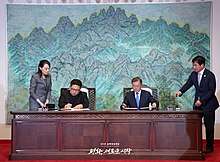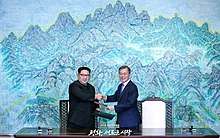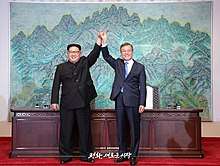Panmunjom Declaration
| Wikisource has original text related to this article: |
| Korean Wikisource has original text related to this article: |
| Panmunjom Declaration | |||||||
| South Korean name | |||||||
|---|---|---|---|---|---|---|---|
| Hangul | 한반도의 평화와 번영, 통일을 위한 판문점 선언 | ||||||
| Hanja | 韓半島의 平和와 繁榮, 統一을 爲한 板門店 宣言 | ||||||
| |||||||
| North Korean name | |||||||
| Chosŏn'gŭl | 조선반도의 평화와 번영, 통일을 위한 판문점 선언 | ||||||
| Hancha | 朝鮮半島의 平和와 繁榮, 統一을 爲한 板門店 宣言 | ||||||
| |||||||
The Panmunjom Declaration for Peace, Prosperity and Unification of the Korean Peninsula was adopted between the Democratic People's Republic of Korea's Kim Jong-un and the Republic of Korea's Moon Jae-in on April 27, 2018, during the 2018 inter-Korean Summit on the South Korean side of the Peace House in the Joint Security Area.
According to the declaration, the leaders of North and South Korea agreed to work together on ending the Korean War and the Korean conflict, beginning a new era of peace and sharing commitments in ending divisions and confrontation by approaching a new era of national reconciliation, peace and prosperity and improvements to inter-Korean relations.[1]
This declaration includes the denuclearization of the Korean Peninsula.[2]
Summary of the Panmunjom Declaration



- The full text of Panmunjom Declaration article is located in Panmunjom Declaration [3]
During this momentous period of historical transformation on the Korean Peninsula, reflecting the enduring aspiration of the Korean people for peace, prosperity and reunification, President Moon Jae-in of the Republic of Korea and Chairman Kim Jong-un of the State Affairs Commission of the Democratic People's Republic of Korea held an Inter-Korean Summit Meeting at the 'Peace House' at Panmunjom on April 27, 2018.[4]
The two leaders solemnly declared before the 80 million Korean people and the whole world that there will be no more war on the Korean Peninsula and thus a new era of peace has begun.
1. Promote common prosperity and reunification of Korea through dramatic improvement and development of inter-Korean relations
- Continue high-level working-level talks for the full implementation and implementation of the agreement
- Establishment of Joint Liaison Office in Gaeseong between South and North Korea
- Multilateral cooperation and exchange
- Inter-Korean Red Cross talks and reunions of separated-families on 15 August 2018
- Connecting and modernizing roads with Donghae and Gyeongui railways
2. Elimination of military tension and substantial elimination of war risk
- Cease all hostile acts
- Designed as a peace zone in the western part of the west coast
- Establishment of military mutual guarantee measures through high-rank military-level talks
3. Establishing a permanent and peaceful Korean peninsula peace regime
- Inviolable agreement
- Stepwise disarmament
- In celebration of the 65th anniversary of the Korean Armistice Agreement in 2018, South and North Korea corporate closely with the US and China to establish a peace treaty on the Korean peninsula after ending the 1953 Korean War.
- Finalise the complete denuclearization of the Korean peninsula
The two leaders agreed, through regular meetings and direct telephone conversations, to hold frequent and candid discussions on issues vital to the nation, to strengthen mutual trust and to jointly endeavor to strengthen the positive momentum towards continuous advancement of inter-Korean relations as well as peace, prosperity and reunification of the Korean Peninsula.In this context, President Moon Jae-in agreed to visit Pyongyang this fall.
See also
Notes
- ↑ "Panmunjom Declaration: The key points | Dhaka Tribune". Dhaka Tribune. 27 April 2018. Retrieved 28 April 2018.
- ↑ Fifield, Anna (27 April 2018). "In a feel-good Korea summit, Kim lays the groundwork for meeting with Trump". Washington Post. Retrieved 28 April 2018.
- ↑ https://en.wikisource.org/wiki/Panmunjom_Declaration
- ↑ Japantimes.co.jp - Panmunjom Declaration 26 June 2018: Full text of Panmunjom Declaration